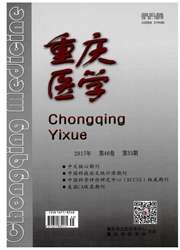

 中文摘要:
中文摘要:
目的探讨和分析不同年龄段慢性鼻-鼻窦炎患者的生存质量和影响因素。方法对2010~2012年收住院的90例慢性鼻-鼻窦炎患者进行术前和术后调查,并采用生存质量量表(SNOT-20)评分。结果少儿患者、青年患者和中老年患者术后的生存质量水平同术前比较均有显著改善,差异有统计学意义(P〈0.05)。少儿组改善最显著的依次为第一维度(鼻塞70%)、第二维度(记忆力下降30%)、第三维度(担忧病情30%)和第四维度(影响社交40%)。青年组改善最显著的依次为第一维度(鼻塞73.3%)、第四维度(影响社交43.3%)、第二维度(影响睡眠质量20.0%)和第三维度(烦躁易怒16.7%)。中老年组改善最显著的依次为第一维度(鼻塞66.7%)、第三维度(担忧病情20%)、第二维度(影响睡眠质量20.0%)和第四维度(造成经济负担40.0%)。术前生存相关影响因素主要为并发症、年龄、性别、病程和城乡,术后主要为并发症、病程、年龄、围术期处理、性别和城乡。结论不同年龄段患者鼻内窥镜术后生存质量改善方面有所差异。提高患者围术期的处理的依从性可以显著改善术后生存质量。
 英文摘要:
英文摘要:
Objective To evaluate how functional endoscopic sinus surgery(FESS)modifies patients symptom profiles and the quality of life and analyze the influential factors.Methods During 2010to 2012,90 cases were investigated to evaluate the quality of life of different age groups to use SNOT-20.Results The quality of life after the surgery of different age groups were significantly higher than it before the surgery(P0.05).The juvenile group:first dimension(nasal congestion,70%),the second dimension(memory,30%),the third dimension(worried about the condition,30%)and the fourth dimension(social influence,40%).The young aged group:first dimension(nasal congestion,73.3%),the fourth dimension(social influence,43.3%),second dimension(quality of sleep,20.0%)and the third dimension(irritability,16.7%).The middle and old aged group:first dimension(nasal congestion,66.7%),the third dimension(trepidation,20%),the second dimension(quality of sleep,20.0%)and the fourth dimension(financial burden,40.0%).Preoperative QOL related factors:complications,age,gender,disease duration and urban-rural;Postoperative QOL related factors:complications,disease duration,age,perioperative management,gender and urban-rural.Conclusion The quality of life of different ages after FESS is improved in different aspects.To increase the level of perioperative compliance can improve the quality of life.
 同期刊论文项目
同期刊论文项目
 同项目期刊论文
同项目期刊论文
 期刊信息
期刊信息
